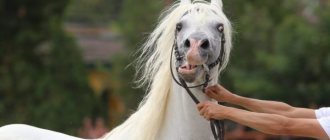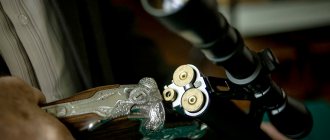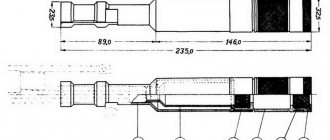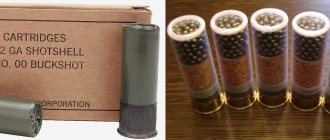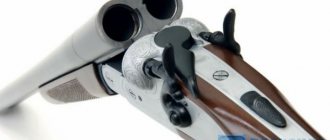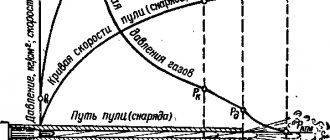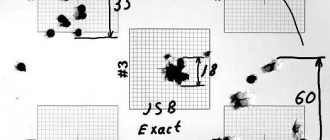()
When preparing for a hunt, not only the weapon and cartridge play an important role, but also the correct choice of the damaging element in it - the “projectile” in weapons terminology. For a smoothbore gun, this can be either shot or buckshot, or a single, solid bullet. In this article we will not delve too deeply into the issues of external and internal ballistics, but will give only the general understanding necessary for a novice shooter on how to choose the right cartridge for hunting.
To learn how to choose the right shot or buckshot for hunting, read the article: Shot and buckshot by numbers: what are they?
So, you realized that you have to go after a large and dangerous animal, or that meeting one during a hunt is very likely. Neither buckshot nor, especially, shot satisfies us in this case, and here comes the moment when a bullet comes onto the scene.
A little theory
To begin with, bullets can be divided into two types:
- Caliber - in this case, the body of the bullet itself is in direct contact with the walls of the barrel.
- Sub-caliber, they are also container - the bullet is enclosed in a so-called container, usually made of polyethylene, and the diameter itself is smaller than the diameter of the barrel. Accordingly, when it passes through the barrel, it does not come into contact with its walls - the container does this for it.
What are the advantages of both types of bullets? Let's start with the sub-caliber ones:
- Longer shot range and flatter trajectory. This is achieved due to the lighter weight of the bullet itself, with the same amount of gunpowder used, as well as better (usually) aerodynamics.
- Less lead in the barrel is due to the fact that the container is in contact with its walls, and not the bullet itself.
What then are caliber ones? They have their advantages:
- Much greater stopping effect when shooting at close range. This is achieved due to the fact that such a bullet, being heavier and wider than a sub-caliber one, transfers significantly more energy to the animal directly upon impact.
- Insensitivity to frost - in the cold, the polyethylene container of sub-caliber bullets tends to harden, and, due to this, they begin to behave differently than at normal temperatures. Caliber bullets do not have such a drawback - their ballistics remains unchanged regardless of the value of the thermometer.
What conclusion can we draw from this? That's right - we need to look at what kind of animal and at what distance we are going to hit. Someone dangerous and large, who, moreover, will rush at us or let us come close to him - like a seasoned cleaver or a bear? Then you should choose a heavy caliber bullet - in order to be sure to stop an evil and wound-resistant beast, and not wait until it dies from blood loss, while collecting in a heap its own intestines, released during the attack. Are we planning to shoot at a longer distance, or are we confident that we can accurately hit the prey in its lethal zone? Then our choice is a sub-caliber bullet.
Not by caliber
PHOTO: SHUTTERSTOCK
Whatever point of view hunters adhere to, it is quite obvious that for a particular gun you need to select a specific bullet and load.
One of the features of smooth-bore weapons is the presence of chokes at the end of the barrels - choke constrictions.
It is this feature that makes choosing a bullet difficult.
Of course, there are guns without constrictions, but they are relatively rare; usually these are weapons for short-range shooting, namely with a bullet or large buckshot.
The conclusion from this is this: if you have a shotgun, then with a probability of 95% one of its barrels has a narrowing.
This, in turn, raises the question of how to choose the right bullet for your barrel.
| PHOTO: SHUTTERSTOCK |
Before looking at the types of bullets, let's look at where the most promising uses for shotguns with a slug cartridge are. Since the bullet's caliber is large enough and its weight is large, it has a tremendous stopping effect.
Such a weapon will be optimal where an instant stopping effect is needed, but the firing distance is short. This is, for example, driven hunts in the forest or the collection of wounded animals of large or dangerous animals.
Few things can compare to the stopping power of a 12-gauge double-barreled shotgun loaded with 36-gram Brenneke lead bullets.
Modern Sauvestre bullets have good accuracy and can easily hit a target at a distance of up to 70–80 meters, which is enough for driven hunts in the forest.
| PHOTO: ANTON ZHURAVKOV, SHUTTERSTOCK |
For modern guns, correctly selected bullets do not pose any problem, but weapons, especially European ones from the beginning of the century, cope with them poorly.
In Europe, it was not customary to shoot bullets from shotguns; there were special guns for this, and if there was a frequent need to combine animal and bird hunts, you could purchase a tee.
This is what can explain the fact that the barrel of shotguns at the muzzle is very thin. This is not important for cylinders, but for chokes or pressure chokes it can be fatal, so it is not recommended to shoot bullets of any design from old guns.
Before talking about sub-caliber bullets, let's consider some features of lead bullets for smooth-bore weapons in general. And let's start with the simplest ones - spherical and cylindrical.
It should immediately be noted that they are caliber, i.e. their diameter strictly corresponds to the diameter of the barrel bore, as a result of which they are categorically not recommended for use in weapons that have any narrowing.
The simplest round bullet is an ordinary lead ball, the diameter of which is equal to the caliber of the weapon. The advantages of this bullet (ease of manufacture and good accuracy), as well as the disadvantages, are obvious; all other things being equal, such a bullet will always be lighter than a cylindrical one.
In addition, round bullets are prone to ricochets, so they were prohibited for use in round-ups and driven hunts.
| Cap bullets are an interesting type of projectile. PHOTO: ANTON ZHURAVKOV, SHUTTERSTOCK |
For shooting from weapons with choke constrictions, the Sputnik bullet was invented - the same round bullet, but with leading crushable ribs. The ability to fire a round bullet through chokes had to be paid for by reducing the weight of the projectile.
A cylindrical bullet, such as the Lot, has sufficient weight, but retains the disadvantages of a conventional round bullet, in particular, the inability to fire from weapons with choke constrictions. Simple lead bullets have now been practically replaced by more modern projectiles.
| Mayer's turbine bullet enjoyed deserved popularity among hunters. PHOTO: SHUTTERSTOCK |
As can be clearly seen from the example of a round bullet, the price to pay for sub-caliber is always weight loss. Fortunately, part of this loss can be compensated for by the initial velocity, and in practice we see that all sub-caliber bullets have a much higher speed than their caliber “sisters”.
As always, this has its pros and cons. On the one hand, the higher the speed, the flatter the trajectory and the smaller the bullet drop; on the other hand, by reducing the diameter of the bullet, we reduce the stopping effect, but for the 12 gauge this is not so critical.
Reducing the caliber had a very good effect on the versatility of the bullets; such bullets, unlike caliber bullets, are harmless for any chokes. And the issue of matching the barrel diameter was resolved through the use of containers and non-detachable wads.
| At short ranges, a shotgun bullet has excellent effectiveness. PHOTO: ANTON ZHURAVKOV, SHUTTERSTOCK |
Historically, leading ribs were used to center sub-caliber bullets; many bullets were invented: the above-mentioned “Sputnik”, and the Mayer turbine bullet, and the same Brenneke - all have leading belts of one shape or another.
The main purpose of these belts is to pass chokes. Sometimes the belts are made in a curved shape, and then they must twist the bullet. In practice, I saw the mark that Mayer’s bullet leaves in the barrel, and I really believe that it is twisted in the barrel, since this mark resembles rifling, which means that the belts work.
Unfortunately, although the belts save barrels with chokes, when passing through them the bullet is greatly deformed. This often explains why such bullets show excellent results in cylinder barrels, but very mediocre results in tapered barrels.
The next step was the use of containers, and the most widespread were bullets with widespread use of polyethylene. And this is understandable: polyethylene is cheap, pours well into any shape, and is not afraid of overloads and high heat.
Detachable containers usually consist of two halves; they can be supplemented with a tray, which often serves as a shank for a bullet, as, for example, on the Strela or Polev bullet. After leaving the barrel, the container opens, the halves fly off, and the bullet continues its linear motion.
| PHOTO: ANTON ZHURAVKOV |
The disadvantage of this design is that the bullet is light; the container takes up too much space and sometimes does not open immediately; more precisely, the halves can separate at the same time, which leads to a sharp change in trajectory.
This kind of flaw was a real scourge of Polev’s first bullets, and the designer spent a lot of effort on correcting it.
The second option is a non-detachable container. With this design, the bullet or roller is directly fused into a container that is part of the bullet. This design does not have the disadvantages of the first and shows excellent results when shooting.
As an example, let’s take the Mitichkin bullet, the design of which is so durable that hunters, after removing it from the animal, use it again.
Arrow-shaped bullets are considered truly sub-caliber. In them, the center of gravity is shifted forward, towards the head of the bullet, while the rear part consists of a lighter stabilizer shank. This device allows the bullet to self-orient in flight.
This is one of the largest classes of bullets, which includes “Vyatka”, “Kirovchanka”, Poleva, McElveen, Brenneke and “Strela”. They are most often sub-caliber and placed in a container. Loading a cartridge with such a bullet is easy: just pour gunpowder into the cartridge case and send the bullet onto it in a container.
This design causes much less lead in the barrel when fired. In addition, the polyethylene container prevents the bullet from deforming during the shot.
| Increasingly, you can find a combination of metal and plastic in bullets. PHOTO: ANTON ZHURAVKOV |
Also on the body of the bullet there may be longitudinal or transverse ribs that allow it to pass through the chokes. Some bullets have oblique ribs, which, according to the designer's plan, should spin the bullet in the barrel and then in the air.
There is an opinion that such ribs do not work, and this is easy to believe when you see what the ribs turn into after a bullet passes through the choke.
But on the other hand, after firing such a bullet, as described above, a helical trace is observed inside the barrel, similar to rifling in a rifled barrel, and these traces eloquently indicate that the bullet is still twisting inside the barrel.
There is another interesting option - a cap bullet. Externally, in all respects it is a caliber bullet, but its design has crushable elements. In appearance, they resemble a thimble with a thickening in the front part. The most famous representatives of cap bullets are the Foster bullet and the Diabolo.
Their device is simple for handicraft production and very effective when used for hunting. The bullets have good ballistics and are best suited for shooting from guns with a paradox drill (a small area at the end of the barrel with rifling).
Cap bullets with a blunt nose have good stopping power, but quickly lose speed.
| A new trend is a plastic bullet with a metal filler. PHOTO: ANTON ZHURAVKOV |
There are also options with a sharp nose - with a greater striking distance and penetrating power. Typically, these bullets do not have any devices for stabilization in flight, since the center of gravity is shifted forward and does not require additional stabilization.
To pass choke constrictions, the bullet may have special ribs - straight or oblique.
| PHOTO: ANTON ZHURAVKOV, |
These bullets are popular among fans of “paradoxes” and recreational shooting, because, having less weight than a regular bullet, they have good accuracy and low recoil.
BULLETS SELECTION
As we can see, bullets for smooth-bore weapons are very diverse and choosing them for hunting can cause certain difficulties. Before choosing a bullet, you need to understand where and on what hunts you plan to use it.
It's also a good idea to know what type of weapon you'll be shooting with. The fact is that if you have a standard double-barreled shotgun with a combination of choke-polochok barrels, then you cannot use solid bullets without ribs, but on the other hand, bullets with ribs must meet the criterion of the diameter of the bullet body, which we are talking about wrote above.
Practice shows that barrels with different constrictions have different bullet impacts. It is also possible that you need to select your own bullet for each barrel.
So, if you plan to hunt bear at close ranges, such as in a den, then it is better to choose the heaviest bullets in your caliber, such as the Brenneke. These bullets have mediocre ballistics but great stopping power.
If you plan to hunt in a paddock and the distance to the target may be different, then it is better to take arrow-shaped or turbine bullets, which have better ballistics.
It is imperative that before using any bullet for hunting, it must be shot from your gun. Zeroing will make it possible not only to bring the gun to normal combat, but also to understand how the selected bullet behaves with a change in the distance to the target.
It must be remembered that choosing a bullet is always a compromise between accuracy and power. Unfortunately, it is impossible to select a bullet that simultaneously satisfies all the criteria.
Alexander Mishin December 18, 2022 at 1:03 pm
Bullets and chokes: how not to kill a gun?
To reduce the dispersion of shot when firing, many hunting rifles are equipped with so-called “chokes” - muzzle constrictions of varying degrees. In this article we will not go into details of what they are and why they are needed, but will only note that their presence requires care when choosing bullets for shooting - the “stronger” the choke, the less opportunity it leaves for their use .
A short table of the choke-bullet ratio is as follows:
- Cylinder (no constriction) – shooting of all types of bullets is allowed;
- Cylinder with pressure (constriction 0.25 mm) – shooting of all types of bullets is allowed. For a round caliber - if it passes through the bore with light friction.
- Poluchok (narrowing 0.5 mm), medium choke (narrowing 0.75 mm) - shooting with special and sub-caliber bullets is allowed;
- Full choke (1 mm narrowing) – shooting with special and round sub-caliber bullets is allowed.
- Reinforced choke (constriction 1.25 mm) or more - shooting with bullets is prohibited.
Another important point for owners of weapons with interchangeable choke tubes - don’t shoot without these tubes at all! In any case, if you don’t want to ruin your gun, one shot, no matter whether it’s a bullet or a shot, will completely strip the thread, depriving you of the ability to use replaceable chokes.

